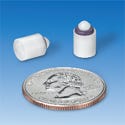Prosthetics Benefit from Modified Valve
Tweaking a supplier’s valve resulted in enhanced comfort for prosthetics patients
May 9, 2008
Originally Published MPMN May 2008
ENGINEERING SOLUTIONS
Prosthetics Benefit from Modified Valve
Tweaking a supplier's valve resulted in enhanced comfort for prosthetics patients
|
A valve allows for the automatic expulsion of air from a prosthetic device without leaking. |
As both CEO of Energy Prosthetics (Winnetka, CA; www.energyprosthetics.com) and an amputee, Adam Soss possesses personal insight into the design flaws of prosthetic devices. Among the most problematic components is the valve used to allow residual air to escape the device's socket during insertion. This creates suction, which holds the device in place. However, a problem occurs when a patient sits down; a small amount of air leaks past the skin and the socket's flexible liner. Upon standing, this tiny amount of air needs to be expelled or it may cause patient discomfort.
"Manufacturers have tried [employing] autoexpulsion valves, but they have a tendency to leak or clog, which discourages prosthetic wearers from using these products," Soss says.
Prosthetic valves can also pose problems for geriatric patients with poor hand dexterity because they are threaded into a base, according to Soss. He adds that another drawback of many valves is that they require manual actuation by the user.
After brainstorming with engineer Dustin Bouch, Soss conceived a "push-in valve" for a new prosthetic design, which would not require that the valve be threaded into the device. The component would act like an autoexpulsion valve, but would be free from leaking and clogging problems.
Because the project's budget did not accommodate building a custom valve, the team decided to find and modify an existing one. Soss found Smart Products (Morgan Hill, CA; www.smartproducts.com) through a Google search for check valves.
The company sent him samples, but none of them were quite right for the prosthetic prototype. "Smart Products not only sent me samples; the salesperson actually went looking around the plant for a valve that would work for me because I couldn't afford to have the company develop a whole new mold," Soss says.
The salesperson suggested a shortened version of the company's 110 check valve, which had already been modified for a previous project. It was suitable for the prosthetics application because it didn't protrude outside the device. Furthermore, the valve featured Smart Products's design in which a spring-loaded poppet pushes against the O-ring, producing a positive seal. Energy Prosthetics was able to select the precise pressure required to create the necessary suction in the new design, owing to the supplier's selection of spring rates.
Smart Products worked with Energy Prosthetics to determine spring pressures and customized O-ring materials for the valve, allowing the manufacturer to fine-tune the valve as the prototype evolved. However, the project encountered an obstacle in development when it was discovered that the mold no longer existed because too much time had elapsed since the modified 110 check valve had been produced. Because the budget did not allow for the engineering of a new mold, Energy Prosthetics bought out the remainder of the modified 110 check valve stock in order to bring the prosthetic to market.
Using the Smart Products valve, the new prosthetic device allows for the automatic expulsion of air without the valve leaking or clogging. Prosthetic device company Otto Bock Healthcare GmbH (Duderstadt, Germany; www.ottobock) recently purchased the PushValve and MagValve rights from Energy Prosthetics; Smart Products will continue to manufacture the modified autoexpulsion valve once the company begins making the prosthetic device.
Copyright ©2008 Medical Product Manufacturing News
You May Also Like



